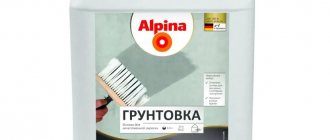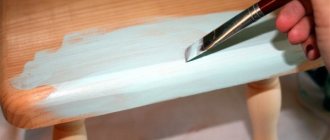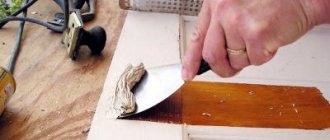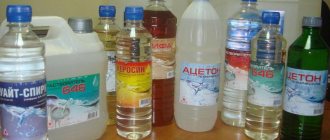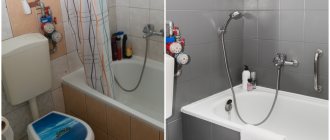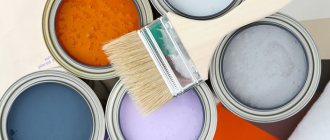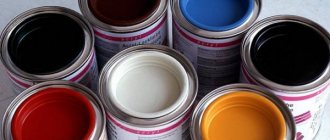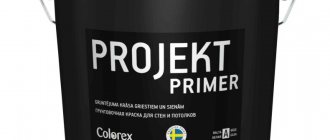Paint consumption in reality theory
The consumption of acrylic facade paint per 1m2 is influenced by many parameters:
- Is it diluted and with what exactly?
- number of layers;
- surface features;
- application method used.
Manufacturers promise that one liter of facade paint should be enough for 8 m2, but most often this figure is overestimated. This is due to the fact that such consumption is achieved by applying one thin layer to a surface without roughness. In reality, one liter is enough for approximately 6-7 m2 of surface.
Roughness and absorbency also have an impact. The larger they are, the more paint will be required when painting the facade. Using a brush significantly increases material consumption. You can reduce it somewhat if you use a roller. The most economical spray gun is one that can significantly reduce the consumption of acrylic facade paint.
Proper preparation of the base can also reduce consumption. It must be clean and dry, then the paint will adhere well to it and the number of layers can be reduced to two. If a cheap composition is used, then the surface will have to be coated three times.
Methods for thinning acrylic paint
How can you dilute façade acrylic paint? It is based on plain water, so you can dilute it with clean liquid. The main rule is that it must be cleaned of foreign impurities. To do this, just let it sit for several hours or pass it through a simple filter. You can then thin the paint and use it.
But when using a painting console, it is necessary to dilute the paint with special compounds sold in hardware stores. They allow you to dilute it to the desired consistency. Otherwise, the spray gun will clog after a short time of operation and fail. At the same time, such compositions make it possible to improve the quality of facade paint by reducing the number of layers required when painting.
There are glossy and matte thinners. With their help, the paint can be given the desired appearance. The first option produces a smooth and shiny surface, while the second is used to create darker, more subtle finishes.
Conclusion
Before using acrylic paint, in most cases it must be diluted with water or a solvent. Using the tips given in the article, you can get material that best suits your needs. With its help, you can bring your wildest design fantasies to life.
You can learn more about painting from the video in this article.
If you decide to buy acrylic-based facade paint for facade finishing or interior work, then you should understand all the nuances of using such a coating. Only in this case can you count not only on a beautiful shade of the walls, but also on the long service life of the resulting decor. This finish is quite easy to apply, but the consistency of the material in the packaging is too thick. If you use it without diluting it, the paint layer on the wall will inevitably be either uneven or too thick, which will negatively affect costs. It is worth clarifying how to dilute façade paint with water in order to obtain high-quality decor.
How to dilute with water
In its original form, acrylic paint has a thick consistency, so it needs to be diluted. For this, special solvents or products recommended by the manufacturer are used.
However, you can use a simple and affordable means for dilution - water. This component is initially included in the composition, so it does not disturb the texture and makes the consistency convenient for application.
It is important to understand that the proportion of water must be strictly observed so as not to spoil the original properties. In addition, for the intended purposes you will only need clean and cool water, without additional impurities.
In painting work, four types of dilution proportions are used:
Ratio 1:1. If you add water in equal quantities to the volume of paint, you will get a consistency suitable for applying a base coat. The liquid will be thick, but will not stick to the roller or brush and will lie evenly over the surface.
Ratio 1:2. If you add two parts of water to one part of paint, you get a composition of a mobile consistency, creating a thin layer on the surface to be painted. Used on smooth surfaces to reduce the intensity of dark colors.
Ratio 1:5. If the amount of water added 5 times the volume of paint, a liquid composition is obtained - tinted water, which will penetrate between the fibers of the working tool. When applied, a barely noticeable layer is formed, which will look interesting when painting textured surfaces.
Ratio 1:15. In this case, the result is ordinary water with a small amount of dissolved dye. This composition is used to create smooth transitions between shades and gradient color designs.
Measure the required amount of water with a syringe or measuring cup to maintain the recommended proportions.
Be careful: you need to dilute acrylic paint with small portions of water, adding gradually. In this case, you cannot stop stirring.
Top manufacturers
The production of acrylic emulsions is often carried out by small companies that do not yet have a regular clientele and have not gained fame. The quality of work of such manufacturers can be high or mediocre.
In order not to make a mistake when choosing a mixture, it is advisable to use facade acrylic paints from well-known manufacturers:
- "Akrial Lux" is designed for harsh weather conditions and can be applied during the cold season;
- Dulux is recommended for external use only and is not used indoors. Treated surfaces receive increased protection in areas with an aggressive climate (temperature changes, frequent precipitation, nearby chemical plants);
- "Admiral" is intended for external and internal work on all types of surfaces (brick, concrete, plasterboard or wood);
- “Oreol” is used primarily for external work and has high vapor permeability;
- Acrylic facade paint for plaster "Ceresit" is used to cover plastered facades. The best interaction is observed when combined with putties of the same brand.
What to do if the paint has dried
It is impossible to accurately calculate the amount of material needed, so professional builders prefer to take it in reserve. After interior finishing, there are situations when some amount of paint remains unused.
The remainder in the jar gradually dries out - the moisture evaporates over time, and polymerization begins. The more liquid “leaves”, the lower the performance characteristics of the composition.
You shouldn’t immediately throw away the damaged material: you can try to revive the paint, returning it to its original properties.
Instructions for restoring dried paint.
Grind the remains into powder with a minimum fraction.
Pour boiling water over for 2-3 seconds , then drain.
Repeat the procedure 2-3 times so that the composition warms up.
Leave the boiling water in the jar and mix the contents thoroughly until smooth.
If the paint has turned into a homogeneous plastic lump, proceed as in the previous case. But at the final stage of resuscitation, add alcohol instead of hot water. Regular women's nail polish, added a little at a time, can also help.
If finances allow, buy acrylic thinner "Gamma" . It is inexpensive, but does an excellent job with paint that has acquired a “rubber” consistency. The product is sold in online stores and specialized retail outlets.
The performance properties of the restored material will be lower than the original ones - the lumps will not completely dissolve, which will negatively affect the strength of the coating. Use this composition for painting minor surfaces that are not noticeable.
If acrylic paint has deteriorated after improper storage, for example, at subzero temperatures, it cannot be restored. In such a situation, irreversible polymerization of the material begins, various substances will be powerless.
Restoration of thickened composition
How to dilute acrylic paint. If the mixture has dried out, this is the result of storing the product in improper conditions. Acrylic lacquers differ from other types of dyes in the ability to restore the desired consistency. The thickened substrate is well diluted and dissolved. To correct the situation, just add distilled water to the paint and mix it thoroughly with a construction mixer.
If there are clots and lumps in the mixture, then alcohol can be added.
Paint for the spray gun is prepared liquid.
Additional recommendations
Working with acrylic paints has nuances and secrets. Here are some of them:
The water must stand for 2-3 hours so that the impurities settle to the bottom. Only after this can it be used to dilute acrylic paints.
When applying the composition using a spray gun, work with branded solvents, adhering to the proportions recommended by the manufacturer. This way you will get a liquid of uniform consistency and achieve uniform coloring of the surface.
Rinse brushes and rollers thoroughly, especially if the work was performed with a highly diluted liquid. This composition is difficult to notice, so the particles remain between the villi. If you subsequently use paint of a lighter shade, the color will be spoiled.
Add the diluent to the composition in portions, thoroughly mixing the composition after each dose. To do this, use a special mixer.
It is not recommended to purchase the material “back to back” - it is advisable to leave a small amount of paint unused. This is necessary for spot restoration of the surface in case of accidental damage.
Regardless of what you choose to thin your acrylic paint with, test the product with a small amount of colorant. If you notice the formation of lumps, you will have to choose another option.
Decorative coating components
Before using this or that paint, it is advisable to understand what substances are included in it. After this, most likely, the problem of choosing a solvent will disappear by itself.
All acrylic paint mixtures have three main components:
- water;
- coloring pigment;
- binders.
The last ingredient in acrylic paint is a polymer emulsion, which contains acrylic. This determines the choice of name for the decorative material in question.
Acrylic paint pigment
Paint has a very wide range of applications: from facade work to coating indoor surfaces. In this case, it practically does not matter what material is painted.
In addition, one of the features of a paint composition containing acrylic is its resistance to ultraviolet radiation. Therefore, the surface remains bright and attractive for a long time.
Well, the last advantages are the price, which makes the finishing material in question one of the most affordable on the market, and ease of use, which is especially important if you decide to carry out repairs yourself.
Advice! It is recommended to use acrylic paint in strict accordance with the manufacturer's recommendations indicated on the label. This way you will achieve the best results.
Thinning acrylic paint
Choice of substance
Before choosing what to dilute acrylic paint with, you should decide on the scope of use. For example, if it is needed for painting furniture or painting, a too thick consistency will not allow you to get rid of defects in the decorative layer that appear from a brush or roller.
There are two types of solvent.
- Water. Considering that this liquid is one of the main components of paint, it is perfect for thinning. Remember that after drying, acrylic, on the contrary, acquires water-repellent properties. Therefore, the tools used should be cleaned immediately after finishing work, otherwise they will become damaged.
- Solvents. The choice of a specific substance depends on which manufacturer of paint you are using. This option is more suitable when, in addition to the desired thickness, you want to give the future coating additional properties (matte, gloss, and so on).
Thinning acrylic paint with a solvent
Note! There are some types of paints, the use of which has its own characteristics. For example, electrically conductive paint Zinga. The nuances of its use are described in the instructions printed on the label.
Water use
To obtain a high-quality mixture, it is recommended to use only clean and cold liquid.
Before diluting the façade acrylic paint, you need to take a small amount of it and add water using a pipette or a bottle in which runny nose drops were sold. This way you can calculate the required proportions.
The water must be clean and cold
There are no strict requirements. The most common options are summarized in the table.
Proportions Result 1:1 The finished mixture becomes less thick and greasy, and when scooping it from a jar it does not form clumps on the brush. The surface is painted evenly. A good option for applying a base decorative layer. 1:2 The paint becomes more liquid and saturates the brush or paint roller well. Allows you to apply a thin layer of paint of the selected shade to the surface. 1:5 In this case, the solution is like colored water, with which you can create a translucent layer on the surface. Similar proportions are used for the so-called “shading” of textured surfaces. The liquid fills all pores, crevices and depressions well, without accumulating on bulges and tubercles. 1:15 This mixture no longer resembles paint. The material becomes like slightly colored water. Used in interior design to create gradients, halftones and smooth transitions from color to color.
Use of solvent
Companies that produce acrylic paints also produce special solvents necessary to impart additional properties to decorative colored coatings.
With the help of certain substances you can get:
- matte surface;
- texture.
glossy finish;
Some additives also speed up drying time, which has a positive effect on the duration of repair work.
Note! Fire-retardant paints for metal Polistil are used only with special additives that do not affect their basic technical characteristics.
Externally, the solvent is a transparent liquid with a specific odor.
They differ in drying speed:
Photo of solvent for acrylic paints
The resulting effects, as in the case of water, depend on the proportions. You can get a light, transparent layer, reminiscent of a watercolor painting, or a thick, rich shade, characteristic of oil paintings.
Solvents and thinners
Water is a natural solvent for acrylic paint. In addition to water, there are a number of diluents offered by the chemical industry that restore the structure of lx. Based on their coefficients, they are divided into three groups.
- Artistic thinners – used in painting and interior design.
- Specialized - manufactured for use in a specific area, taking into account the specific characteristics of the consumer sector. For example, if textile paints have dried out.
- Universal - organic thinners used in all acrylic paints.
Based on drying speed, solutions are divided into three groups, each of which has specific temperature values recommended.
- Slow. This type of acrylic paint thinner is recommended for use in high temperatures. Such thinners slow down the drying of the dissolved substrate and provide a dense covering layer.
- Average. Dissolution is done for work at temperatures from +15 to +25 degrees.
- Fast. The increased evaporation rate reduces the time of complete drying and the removal of excess moisture in low temperature conditions. They are designed for use at -15°C. If the question is: how to dilute façade acrylic paint, then this type of solvent is used.
Thinning dried acrylic paint
Often, improperly stored material dries out and becomes unusable. Most often it goes straight to the trash can. However, if you wish, you can restore the paint. Of course, its characteristics will decrease somewhat.
To do this you need:
What is water emulsion?
Before deciding how to dilute water-based paint for walls, you should study its composition. After all, the type of solvent depends on it.
Water-based solutions are called solutions in which the smallest particles of polymers are evenly distributed in the liquid. During the dyeing process, after the moisture evaporates, they remain on the surface, forming an even layer of whitewash. Such compositions are called dispersed emulsions. They can be used on any type of wall and ceiling from concrete to wood.
If special solvents that can enter into a chemical bond are used to dilute oil paints and enamel, then this is not required for water-based emulsions. The smallest particles of polymers are easily distributed in any liquid medium. Therefore, any types of water-dispersed solutions can be diluted with water.
Types of water-based paint
First, let's figure out what types of dispersed compositions exist. After all, their properties directly depend on the type of binder. They can be made on the basis of:
- cement and lime: quite durable, but not very decorative; it is impossible to obtain a perfectly smooth surface with their help; used mainly for coating concrete, brick in utility rooms, painting facades;
- PVA: the introduction of polyvinyl acetate-based glue allows you to obtain a durable decorative, but not too moisture-resistant coating, so the compositions are recommended to be used only in dry rooms;
- polyacrylate (acrylic): a soft elastic polymer that forms a thin elastic film on the surface; the paint has good hiding power and applies in an even layer; walls and ceilings covered with it can be wiped with a damp cloth; such a water-based emulsion can also be diluted with water;
- latex: artificial rubber, suspended in solution, with properties similar to vinyl; gives the compositions increased water resistance and wear resistance;
- silicone resin, which has good water-repellent and high decorative properties; compositions with its addition can be used even outdoors, the only drawback is the price, they cost a lot.
potassium liquid glass: compositions based on it, called silicate, provide a durable heat- and water-resistant film, but it is difficult to work with such compositions due to low ductility; since glass particles are also a suspension, that is, evenly distributed in the liquid, it is quite acceptable to dilute such water-based paint if it is thick;
Since all of the above types of emulsion are dispersed, that is, the binder in them is distributed in the liquid in the form of a suspension, they can be diluted with ordinary water. But it is worth diluting water-based paint if it is thick.
Expert advice
- if the paint has dried, in order to avoid moisture evaporation, it should be diluted in a small container;
- A tight-fitting jar lid will help get rid of excessive drying;
- It is recommended to wash all tools immediately after completion of work;
- Completely removing dried acrylic paint is a labor-intensive process. Therefore, it is better to cover the surrounding area with protective materials in advance.
The quality of the covering layer directly depends on the degree of viscosity of the paintwork material. Mistakes made can affect not only the appearance of the painted surface, but also the service life.
Acrylic-based paint is one of the popular materials for decorating building facades and carrying out interior work. It is quite easy to apply, but due to its thick consistency, the coating sometimes turns out uneven or too rich. This problem can be easily avoided if you know how to dilute acrylic paint.
Acrylic paint is an excellent material for finishing
